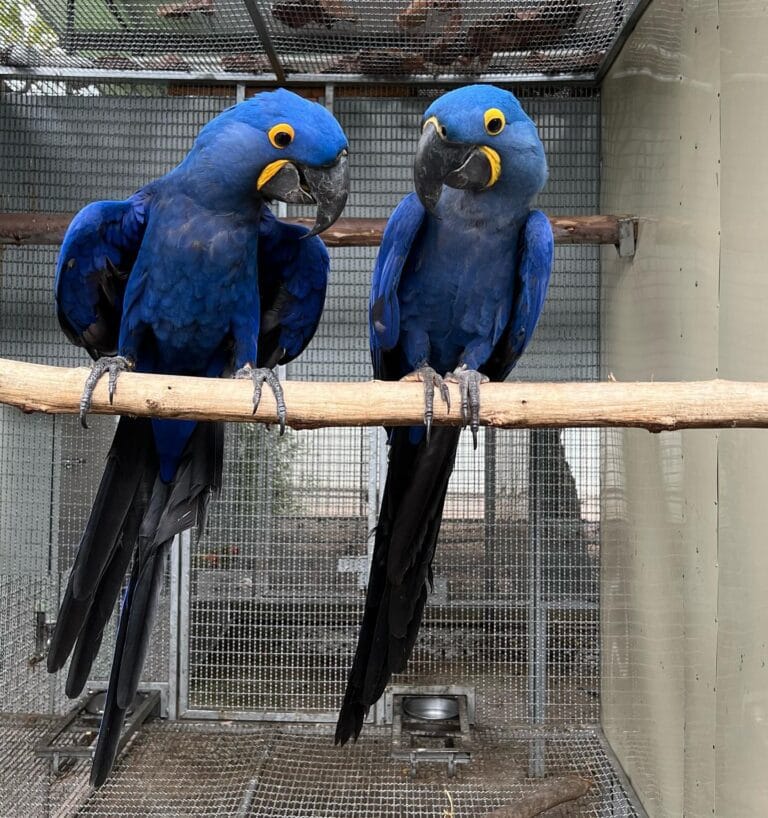What's The Current Job Market For Why Are The Glaceous Macaw And …
페이지 정보
Lizzie 작성일25-02-09 07:38본문
why are the glaceous macaw And Hyancith macaw so alike Are the Hyacinth Macaw and Glaucous Macaw So Similar?
These two species of bird, despite their differences, have similar evolutionary histories. Their dependence on palm swamps for nest and roost highlights the interconnectedness between the natural world and the importance of conserving endangered habitats.
 The hyacinth Macaw is easily identifiable with its bright blue feathers and yellow accents. Its beak, which appears be smiling is capable of tearing coconuts and brazil nuts.
The hyacinth Macaw is easily identifiable with its bright blue feathers and yellow accents. Its beak, which appears be smiling is capable of tearing coconuts and brazil nuts.
The Hyacinth Macaw
The Hyacinth Macaw is by far the largest parrot and is a stunning bird. It is a striking blue colour with yellow accents around the eyes and on the lower part of the beak. This could make it appear as if it's smiling. It has a short, sturdy legs that allow it to hang sideways or upside down. It also has a hook on its beak with a large hook that is adapted to break open coconuts. They are intelligent and social and tend to stay with the same person for the duration of their lives.
Hyacinth macaws do not migrate, and their distribution is closely dependent on the availability of specific palm species that provide their primary food source. This is the primary distinction between macaws, and other parrots that are typically migratory.
The hyacinth Orville macaw parrot price consumes a number of nuts that are native to palm trees. Particularly, the acuri and the bocaiuva. Their powerful beaks permit them to break open these seeds. They also eat fruits and other plant materials.
They are not migratory and their population is dependent on the availability and quality of acuri and Bocaiuva Palms, which provide them with their primary source of food. This is an important distinction between macaws and other parakeets, who are more likely to be migrants.
In contrast to the majority of parrots that prefer rainforests with dense tropical forests, the hyacinth Macaw can be found in less forested areas, such as palm swamps and grasslands that are flooded. The vast majority of the population of the hyacinth macaw is located in the Pantanal, the world's biggest tropical wetland area in Brazil.
Hyacinth Macaws, as with other birds are monogamous. They select one partner when they are about 3-4 years old and stay with them throughout their life. They are extremely social animals and often interact with humans, however it is important to keep in mind that they are wild animals and should never be taken away from their natural habitat.
You can consider adopting a parrot as an animal from an aviculturist who breeds these incredible creatures. It is a big responsibility to care for these amazing creatures, and the best way to ensure their future in captivity is to find an experienced, responsible and reliable aviculturist.
The Glaucous Macaw
The Glaucous Macaw (Ara glaucus) is among the most vibrant birds in the Amazon basin. The large parrot is found in the tropical forests of South America. It has
However, in 2010, analysis of isotopes in macaw feces and eggshells revealed that the glaucous macaw still exist in the wild in northwestern Mexico. The results of the study were published by Science. The authors suggest that glaucous Macaws found in the wild could be a result of the Paquime population in northern Chihuahua. The apparent longevity of the birds is due to the fact that they are very adaptable to their environment and endure in a variety of conditions, including desert conditions.
The Future of the Macaws
Parrots are able to adjust to their environment in an amazing way. In the wild, parrots are able to traverse miles to find nesting sites or mates. They also can mimic human speech. Their feet are designed in such a way that they can perch in trees and climb them. They can carry food through their beaks.
Parrots are not domesticated like dogs and cats, despite their natural abilities. They are still wild animals that must continue to live the way their ancestors did. Due to their wild nature, if you decide to incorporate a parrot into your home, ensure you do it with careful thought and care. Parrots can be loud and large, and they can cause damage to furniture and home. The CITES list also includes them due to habitat loss and over-collection of parrots for the pet industry.
The Spix's Macaw is considered to be one of the most successful reintroduction projects. It was thought to be extinct, until Helmut Sick, his field assistant Dante Teixera and their team observed three of them in 1974 near Formosa do Rio Preto. At the time of the discovery the only pair of birds kept in captivity was at Al Wabra, Qatar.
At a conference in the city of Sao Paulo, Purchase and other conservationists agreed that the best solution was to release captive macaws into the wild. They needed to do it fast, however, since the number of breeding pairs was extremely low. They also needed to establish different lineages in the various breeding centers, to ensure that one pair did not overrun the entire population.
Conservationists then began searching Brazil for Spix's Macaws in private ownership and could be returned to the wild. Owners were initially reluctant to reveal their identities because they could face being charged with breaking a law banning the export of wildlife. However, gradually, "one by one, people started coming forward," says Kiessling.
These two species of bird, despite their differences, have similar evolutionary histories. Their dependence on palm swamps for nest and roost highlights the interconnectedness between the natural world and the importance of conserving endangered habitats.
 The hyacinth Macaw is easily identifiable with its bright blue feathers and yellow accents. Its beak, which appears be smiling is capable of tearing coconuts and brazil nuts.
The hyacinth Macaw is easily identifiable with its bright blue feathers and yellow accents. Its beak, which appears be smiling is capable of tearing coconuts and brazil nuts.The Hyacinth Macaw
The Hyacinth Macaw is by far the largest parrot and is a stunning bird. It is a striking blue colour with yellow accents around the eyes and on the lower part of the beak. This could make it appear as if it's smiling. It has a short, sturdy legs that allow it to hang sideways or upside down. It also has a hook on its beak with a large hook that is adapted to break open coconuts. They are intelligent and social and tend to stay with the same person for the duration of their lives.
Hyacinth macaws do not migrate, and their distribution is closely dependent on the availability of specific palm species that provide their primary food source. This is the primary distinction between macaws, and other parrots that are typically migratory.
The hyacinth Orville macaw parrot price consumes a number of nuts that are native to palm trees. Particularly, the acuri and the bocaiuva. Their powerful beaks permit them to break open these seeds. They also eat fruits and other plant materials.
They are not migratory and their population is dependent on the availability and quality of acuri and Bocaiuva Palms, which provide them with their primary source of food. This is an important distinction between macaws and other parakeets, who are more likely to be migrants.
In contrast to the majority of parrots that prefer rainforests with dense tropical forests, the hyacinth Macaw can be found in less forested areas, such as palm swamps and grasslands that are flooded. The vast majority of the population of the hyacinth macaw is located in the Pantanal, the world's biggest tropical wetland area in Brazil.
Hyacinth Macaws, as with other birds are monogamous. They select one partner when they are about 3-4 years old and stay with them throughout their life. They are extremely social animals and often interact with humans, however it is important to keep in mind that they are wild animals and should never be taken away from their natural habitat.
You can consider adopting a parrot as an animal from an aviculturist who breeds these incredible creatures. It is a big responsibility to care for these amazing creatures, and the best way to ensure their future in captivity is to find an experienced, responsible and reliable aviculturist.
The Glaucous Macaw
The Glaucous Macaw (Ara glaucus) is among the most vibrant birds in the Amazon basin. The large parrot is found in the tropical forests of South America. It has
However, in 2010, analysis of isotopes in macaw feces and eggshells revealed that the glaucous macaw still exist in the wild in northwestern Mexico. The results of the study were published by Science. The authors suggest that glaucous Macaws found in the wild could be a result of the Paquime population in northern Chihuahua. The apparent longevity of the birds is due to the fact that they are very adaptable to their environment and endure in a variety of conditions, including desert conditions.
The Future of the Macaws
Parrots are able to adjust to their environment in an amazing way. In the wild, parrots are able to traverse miles to find nesting sites or mates. They also can mimic human speech. Their feet are designed in such a way that they can perch in trees and climb them. They can carry food through their beaks.
Parrots are not domesticated like dogs and cats, despite their natural abilities. They are still wild animals that must continue to live the way their ancestors did. Due to their wild nature, if you decide to incorporate a parrot into your home, ensure you do it with careful thought and care. Parrots can be loud and large, and they can cause damage to furniture and home. The CITES list also includes them due to habitat loss and over-collection of parrots for the pet industry.
The Spix's Macaw is considered to be one of the most successful reintroduction projects. It was thought to be extinct, until Helmut Sick, his field assistant Dante Teixera and their team observed three of them in 1974 near Formosa do Rio Preto. At the time of the discovery the only pair of birds kept in captivity was at Al Wabra, Qatar.
At a conference in the city of Sao Paulo, Purchase and other conservationists agreed that the best solution was to release captive macaws into the wild. They needed to do it fast, however, since the number of breeding pairs was extremely low. They also needed to establish different lineages in the various breeding centers, to ensure that one pair did not overrun the entire population.
Conservationists then began searching Brazil for Spix's Macaws in private ownership and could be returned to the wild. Owners were initially reluctant to reveal their identities because they could face being charged with breaking a law banning the export of wildlife. However, gradually, "one by one, people started coming forward," says Kiessling.

댓글목록
등록된 댓글이 없습니다.

















